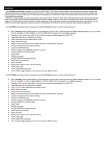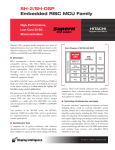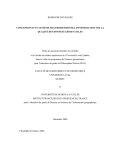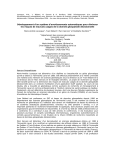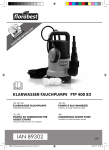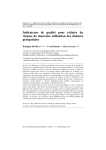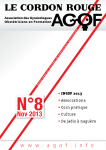Download SH7055 Evaluation Chip Board (HS7055EBK81H
Transcript
To all our customers Regarding the change of names mentioned in the document, such as Hitachi Electric and Hitachi XX, to Renesas Technology Corp. The semiconductor operations of Mitsubishi Electric and Hitachi were transferred to Renesas Technology Corporation on April 1st 2003. These operations include microcomputer, logic, analog and discrete devices, and memory chips other than DRAMs (flash memory, SRAMs etc.) Accordingly, although Hitachi, Hitachi, Ltd., Hitachi Semiconductors, and other Hitachi brand names are mentioned in the document, these names have in fact all been changed to Renesas Technology Corp. Thank you for your understanding. Except for our corporate trademark, logo and corporate statement, no changes whatsoever have been made to the contents of the document, and these changes do not constitute any alteration to the contents of the document itself. Renesas Technology Home Page: http://www.renesas.com Renesas Technology Corp. Customer Support Dept. April 1, 2003 SH7055 Evaluation Chip Board (HS7055EBK81H) for the E8000 Emulator User’s Manual HS7055EBK81HE(A) Notice When using this document, keep the following in mind: 1. This document may, wholly or partially, be subject to change without notice. 2. All rights are reserved: No one is permitted to reproduce or duplicate, in any form, the whole or part of this document without Hitachi’s permission. 3. Hitachi will not be held responsible for any damage to the user that may result from accidents or any other reasons during operation of the user’s unit according to this document. 4. Circuitry and other examples described herein are meant merely to indicate the characteristics and performance of Hitachi’s semiconductor products. Hitachi assumes no responsibility for any intellectual property claims or other problems that may result from applications based on the examples described herein. 5. No license is granted by implication or otherwise under any patents or other rights of any third party or Hitachi, Ltd. 6. MEDICAL APPLICATIONS: Hitachi’s products are not authorized for use in MEDICAL APPLICATIONS without the written consent of the appropriate officer of Hitachi’s sales company. Such use includes, but is not limited to, use in life support systems. Buyers of Hitachi’s products are requested to notify the relevant Hitachi sales office when planning to use the products in MEDICAL APPLICATIONS. Preface This manual describes how to connect and operate the EV-chip board. The EV-chip board incorporates an evaluation chip for connection to a user system that uses the SH7055 with the E8000 emulator. Read and understand Sec. 3, “Preparation before Use” of the E8000 Emulator User’s Manual before using this EV-chip board. CAUTION The EV-chip board is only for connection to a user system that uses the SH7055 with the E8000 emulator. It cannot be used for user systems that target other devices. Contents Section 1 1.1 1.2 Section 2 2.1 Preparation before Use ....................................................................4 Preparing the User System ................................................................................................ 4 2.1.1 Recommended Mounting Pad Dimensions of the User System ........................... 7 2.1.2 Connector Position on the User System ............................................................... 9 Section 3 3.1 Components .....................................................................................1 EV-Chip Board Components ............................................................................................ 1 Component Names ............................................................................................................ 2 Connecting the EV-Chip Board to the User System........................11 Connecting the EV-Chip Board to the User System.......................................................... 11 3.1.1 Connecting the Specified Connector .................................................................... 11 3.1.2 Connecting the Trace Cables to the EV-Chip Board............................................ 12 3.1.3 Connecting the EV-Chip Board to the User System Board.................................. 15 Figures Figure 1.1 Figure 2.1 Figure 2.2 Figure 2.3 Figure 3.1 Figure 3.2 EV-Chip Board....................................................................................................... 2 Recommended Mounting Pad Dimensions............................................................. 8 Connector Position on the User System (Top View).............................................. 10 Component Height Restriction ............................................................................... 10 Connecting Trace Cables to the EV-Chip Board.................................................... 14 Connecting the EV-Chip Board to the User System............................................... 16 Tables Table 1.1 Table 2.1 Table 2.1 Table 2.1 EV-chip Board Components................................................................................... 1 Pin Assignment of the HS7055EBK81H User Interface (UCN1) .......................... 5 Pin Assignment of the HS7055EBK81H User Interface (UCN2) .......................... 7 Pin Assignment of the HS7055EBK81H User Interface (UCN3) .......................... 6 Section 1 Components 1.1 EV-Chip Board Components Table 1.1 lists the product components of the EV-chip board (HS7055EBK81H: 3 x 100-pin connector type). Check all the components after unpacking. Table 1.1 EV-chip Board Components Item Quantity Remarks EV-chip board (HS7055EBK81H) 1 Consists of two boards. • HS7055PWB20H (for connecting to the E8000 station) • HS7055PWB30H (3 x 100-pin connector) Documentation 1 User’s manual for HS7055EBK81H (this manual) Note: Use the specific connector (FX2-100P-1.27SVL manufactured by HIROSE ELECTRIC CO., LTD.) on the user system that is connected to the HS7055EBK81H. 1 1.2 Component Names The component names of the EV-chip board are described below. 1 UC N2 UC N3 CN 3 U CN 1 Pin 1 CN 2 2 CN 1 3 X 1 X0 5 B ottom view 4 T op view Station to E V -chip board interface connectors 6 7 8 S ide view Figure 1.1 EV-Chip Board 1. Station to EV-chip board interface connector CN3: For trace cable 3 which connects the E8000 station to the EV-chip board. 2. Station to EV-chip board interface connector CN2: For trace cable 2 which connects the E8000 station to the EV-chip board. 3. Station to EV-chip board interface connector CN1: For trace cable 1 which connects the E8000 station to the EV-chip board. 4. Crystal oscillator terminals: For installing a crystal oscillator to be used as a clock source for the SH7055. 5. User-system connector: For connecting the user system. 6. Board connector: For connecting HS7055PWB20H and HS7055PWB30H. 7. HS7055PWB20H: Includes connectors for interfacing with the E8000 station via trace cables. 2 8. HS7055PWB30H: Includes connectors for interfacing with the user system. 3 Section 2 Preparation before Use 2.1 Preparing the User System Table 2.1 lists the user interface pin assignment of the specific connector (FX2-100P-1.27SVL manufactured by HIROSE ELECTRIC CO., LTD.) when the target MCU is the SH7055. 4 Table 2.1 Pin Assignment of the HS7055EBK81H User Interface (UCN1) Pin No. Pin Name Pin No. Pin Name Pin No. Pin Name 1 GND 35 PJ6/TIO2G 69 PK15/TO8P 2 GND 36 PJ7/TIO2H 70 GND 3 GND 37 GND 71 GND 4 GND 38 PJ8/TIO5C 72 GND 5 AN16 39 PJ9/TIO5D 73 GND 6 AN17 40 PJ10/TI9A 74 PL0/TI10 7 AN18 41 PJ11/TI9B 75 PL1/TIO11A/IRQ6 8 AN19 42 GND 76 PL2/TIO11B/IRQ7 9 GND 43 PJ12/TI9C 77 PL3/TCLKB 10 AN20 44 PJ13/TI9D 78 GND 11 AN21 45 PJ14/TI9E 79 PL4/ADTRG0 12 AN22 46 PJ15/TI9F 80 PL5/ADTRG1 13 AN23 47 GND 81 PL6/ADEND 14 GND 48 GND 82 PL7/SCK2 15 AN24 49 GND 83 GND 16 AN25 50 GND 84 PL8/SCK3 17 AN26 51 PK0/TO8A 85 PL9/SCK4/IRQ5 18 AN27 52 PK1/TO8B 86 PL10/HTxD 19 GND 53 PK2/TO8C 87 PL11/HRxD 20 AN28 54 PK3/TO8D 88 GND 21 AN29 55 GND 89 PL12/IRQ4 22 AN30 56 PK4/TO8E 90 PL13/IRQOUT 23 AN31 57 PK5/TO8F 91 GND 24 GND 58 PK6/TO8G 92 GND 25 GND 59 PK7/TO8H 93 GND 26 GND 60 GND 94 GND 27 GND 61 PK8/TO8I 95 Not connected 28 PJ0/TIO2A 62 PK9/TO8J 96 Not connected 29 PJ1/TIO2B 63 PK10/TO8K 97 Not connected 30 PJ2/TIO2C 64 PK11/TO8L 98 Not connected 31 PJ3/TIO2D 65 GND 99 Not connected 100 Not connected 32 GND 66 PK12/TO8M 33 PJ4/TIO2E 67 PK13/TO8N 34 PJ5/TIO2F 68 PK14/TO8O 5 6 Table 2.1 Pin Assignment of the HS7055EBK81H User Interface (UCN2) Pin No. Pin Name Pin No. Pin Name Pin No. Pin Name 1 AVCC 35 PA5/TIO3B 69 PC0/TxD1 2 GND 36 PA6/TIO3C 70 PC1/RxD1 3 AVREF 37 PA7/TIO3D 71 PC2/TxD2 4 AVREF 38 GND 72 PC3/RxD2 5 GND 39 PA8/TIO4A 73 PC4/IRQ4 6 GND 40 PA9/TIO4B 74 GND 7 AN0 41 PA10/TIO4C 75 PG0/PULS7/HRxD 8 AN1 42 PA11/TIO4D 76 PG1/IRQ1 9 AN2 43 GND 77 PG2/IRQ2/ADEND 10 AN3 44 PA12/TIO5A 78 PG3/IRQ3/ADTRG0 11 GND 45 PA13/TIO5B 79 GND 12 AN4 46 PA14/TxD0 80 TMS 13 AN5 47 PA15/RxD0 81 /TRST 14 AN6 48 GND 82 TDI 15 AN7 49 PB0/TO6A 83 TDO 16 GND 50 PB1/TO6B 84 TCK 17 AN8 51 PB2/TO6C 85 GND 18 AN9 52 PB3/TO6D 86 /AUDRST 19 AN10 53 GND 87 AUDMD 20 AN11 54 PB4/TO7A/TO8A 88 GND 21 GND 55 PB5/TO7B/TO8B 89 AUDD0 22 AN12 56 PB6/TO7C/TO8C 90 AUDD1 23 AN13 57 PB7/TO7D/TO8D 91 GND 24 AN14 58 GND 92 AUDD2 25 AN15 59 PB8/TxD3/TO8E 93 AUDD3 26 GND 60 PB9/RxD3/TO8F 94 GND 27 /WDTOVF 61 PB10/TxD4/HTxD/TO8G 95 AUDCK 28 GND 62 PB11/RxD4/HRxD/TO8H 96 /AUDSYNC 29 PA0/TIOA 63 GND 97 GND 30 PA1/TIOB 64 PB12/TCLKA 98 PVCC2 31 PA2/TIOC 65 PB13/SCK0 99 GND 32 PA3/TIOD 66 PB14/SCK1/TCLKB 100 FWE 33 GND 67 PB15/PULS5/SCK2 34 PA4/TIO3A 68 GND 7 8 Table 2.1 Pin Assignment of the HS7055EBK81H User Interface (UCN3) Pin No. Pin Name Pin No. Pin Name Pin No. Pin Name 1 NMI 35 MD1 69 GND 2 GND 36 MD2 70 PE7/A7 3 PVCC1 37 GND 71 PE6/A6 4 GND 38 EXTAL 72 PE5/A5 5 PH15/D15 39 GND 73 PE4/A4 6 PH14/D14 40 PF15/BREQ 74 GND 7 GND 41 PF14/BACK 75 PE3/A3 8 PH13/D13 42 PF13/CS3 76 PE2/A2 9 PH12/D12 43 PF12/CS2 77 PE1/A1 10 GND 44 GND 78 PE0/A0 11 PH11/D11 45 PF11/CS1 79 GND 12 PH10/D10 46 PF10/CS0 80 PD0/TIO1A 13 GND 47 PF9/RD 81 PD1/TIO1B 14 PH9/D9 48 PF8/WAIT 82 PD2/TIO1C 15 PH8/D8 49 GND 83 PD3/TIO1D 16 GND 50 PF7/WRH 84 GND 17 PH7/D7 51 PF6/WRL 85 PD4/TIO1E 18 PH6/D6 52 PF5/A21/POD 86 PD5/TIO1F 19 GND 53 PF4/A20 87 PD6/TIO1G 20 PH5/D5 54 GND 88 PD7/TIO1H 21 PH4/D4 55 PF3/A19 89 GND 22 GND 56 PF2/A18 90 PD8/PULS0 23 PH3/D3 57 PF1/A17 91 PD9/PULS1 24 PH2/D2 58 PF0/A16 92 PD10/PULS2 25 GND 59 GND 93 PD11/PULS3 26 PH1/D1 60 PE15/A15 94 GND 27 PH0/D0 61 PE14/A14 95 PD12/PULS4 28 GND 62 PE13/A13 96 PD13/PULS6/HTxD 29 CLK 63 PE12/A12 97 GND 30 GND 64 GND 98 GND(/UVCCSEL) 31 /RES 65 PE11/A11 99 GND 32 /STBY 66 PE10/A10 100 UVCC(3.3V) 33 GND 67 PE9/A9 34 MD0 68 PE8/A8 9 2.1.1 Recommended Mounting Pad Dimensions of the User System Figure 2.1 shows the dimensions of the recommended mounting pad (footprint) and positioning holes for the specific connector (FX2-100P-1.27SVL) manufactured by HIROSE ELECTRIC CO., LTD. The dimension tolerance is ±0.1 mm unless otherwise specified. 10 3.1 P =1.27±0.05 P in 1 0.8 φ2-1.9 3.3 U CN1 -0 +0.1 Pin 1 P ositioning hole UCN 2 101.0 118.0 pad for fixing 10.0 P in 1 U CN3 62.23±0.10 67.31±0.10 71.95±0.10 U nit:m m T olerance:±0.1m m Figure 2.1 Recommended Mounting Pad Dimensions 11 2.1.2 Connector Position on the User System CAUTION Before connecting the connectors (FX2-100P-1.27SVL) to the user system, check the location of pin 1 and the connector shapes as shown in figures 2.2. If the connector direction is incorrect, the EV-chip board cannot be connected to the user system. Figure 2.2 shows the direction of the connectors (FX2-100P-1.27SVL) on the user system. Comply with the user system component height restriction shown in Figure 2.3 within the external frame of the EV-chip board shown in Figure 2.2. 12 140.0 118.0 39.0 22.0 24.0 11.0 22.0 1 2 100 U CN 3 62.23±0.10 99 71.95±0.10 2 E xternal fram e of the E V -chip board 3.1 99 100 U CN 2 2 1 100 UCN1 99 95.0 1 3.3 U nit: m m T olerance: ±0.1m m Figure 2.2 Connector Position on the User System (Top View) 13 8.7 HS7055PWB30H User system socket FX2-100P-1.27SVL manufactured by HIROSE ELECTRIC CO.,LTD Figure 2.3 Component Height Restriction 14 User system boar Unit: mm Section 3 Connecting the EV-Chip Board to the User System 3.1 Connecting the EV-Chip Board to the User System 3.1.1 Connecting the Specified Connector This EV-chip board is designed exclusively for the specific connector (type number: FX2-100P1.27SVL) manufactured by HIROSE ELECTRIC CO., LTD. Therefore, it cannot be used with other connectors. • Positioning the IC socket The connector FX2-100P-1.27SVL has two positioning pins. Insert the positioning pins of the connector into the positioning holes of the user system board. Apply an epoxy adhesive to the tips of the positioning pins of the connector to bond the connector to the user system board. CAUTION Before connecting the connectors to the user system, check the location of pin 1 on both sides and the connector shapes (UCN1 , UCN2 and UCN3). • Mounting the connectors Solder the FX2-100P-1.27SVL onto the user system. Use more solder than usual so that a fillet is formed on the lead edge being soldered. 15 3.1.2 Connecting the Trace Cables to the EV-Chip Board Always switch OFF the emulator and user system before connecting or disconnecting any CABLES or sockets. Failure to do so will result in a FIRE HAZARD and will damage the user system and the emulator or will result in PERSONAL INJURY. The USER PROGRAM will be LOST. • EV-chip board condition at shipment The EV-chip board is shipped with the HS7055PWB20H and HS7055PWB30H connected to each other. When connecting the EV-chip board to the user system, do not separate the HS7055PWB20H from the HS7055PWB30H. CAUTION Before connecting the EV-chip board to the user system, confirm that the HS7055PWB20H and HS7055PWB30H are firmly connected by lightly pushing the board. • Connecting the trace cables to the E8000 station Before connecting the trace cables to the HS7055PWB20H, connect the trace cables to the E8000 station. Note: At shipment, trace cables CN2 and CN3 to be connected to the E8000 station are bound into a bundle, and trace cables CN1, CN2, and CN3 to be connected to the EV-chip board are bound into a bundle to prevent an insertion error. For more information on connecting the EV-Chip board to the E8000 station, refer to section 3.2.2, Connecting the EV-Chip Board, in the SH7055 E8000 Emulator User’s Manual. 16 • Connecting the trace cables to the EV-chip board Align the trace cables with the station to EV-chip board interface connectors CN1, CN2, and CN3 on the EV-chip board. Confirm that each trace cable connected to a connector on the E8000 station is also connected to its corresponding station to EV-chip board interface connector on the EV-chip board. For the prevention of insertion errors, colors are specified on the trace cable connectors and the corresponding EV-chip board interface connectors (CN1: red, CN2: yellow, CN3: blue). CAUTION For the prevention of insertion errors, colors are specified on the trace cable connectors and the corresponding EV-chip board interface connectors. E xam ple T race cable screw s C N 1:red C N 3:blue C N 2:yellow C N 1:red CN 3 CN 2 CN 1 CN 1 X1 T race cable connector X0 T op view of the H S7055PW B 20H 17 Tighten the screws to connect the trace cable connectors to the station to EV-chip board interface connectors while holding the HS7055PWB30H securely. CN3 CN2 CN 1 H S 7055P W B 20H H S 7055PW B 30H Figure 3.1 Connecting Trace Cables to the EV-Chip Board Make sure the connector shapes and numbers are correctly matched when connecting the trace cables to the station to EV-chip board interface connectors. Failure to do so will result in a FIRE HAZARD. 18 3.1.3 Connecting the EV-Chip Board to the User System Board • Connecting the EV-chip board to the user system board Check the location of the FX2-100P-1.27SVL on the user system. Align the connectors on the HS7055PWB30H of the EV-chip board with those on the user system board, and insert the connectors. CAUTION Forcefully connecting the EV-chip board will apply stress to the soldered connectors on the user system, causing cracks in the solder. Gradually push the EV-chip board repeatedly so that no cracks occur in the soldered section of the connectors. 19 CN3 CN2 CN1 H S7055P W B 20H U CN 1 N2 C U U C N3 H S 7055PW B 30H U sersystem Figure 3.2 Connecting the EV-Chip Board to the User System 20



























